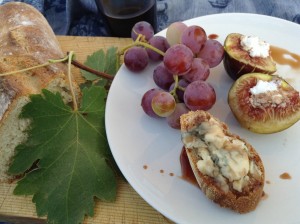How to Make Mosto Cotto (Vino Cotto Recipe)
Also called vino cotto, saba, and petimezi, mosto cotto means “cooked must.” The “must” is smashed grapes that in this case are cooked down into a delectable sweet sauce with the consistency of maple syrup. It is heavenly on fruit, cheese, or in salad dressings.

Mosto cotto on blue cheese
This is an ancient recipe found in countries all around the Mediterranean. It was originally used to create a sweetener in the era before sugar cane was introduced to that part of the world.
Wine grapes were usually used to make mosto cotto. They contain as much as 25% natural sugars, which is much higher than the sugar content of most wild grapes, and even than that of store-bought table grapes.
grapes ripening on the vine
If you like, you can add up to 1 1/2 cups of sugar to the grape must in this recipe to approximate the sweetness of wine grapes. You can leave the sugar out, but then be prepared to get a much smaller yield of mosto cotto (as little as 1/2 cup).
Mosto Cotto (Vino Cotto) Recipe
Makes 1 to 2 cups
Ingredients:
- 1 tablespoon grape vine ash (optional but traditional: see instructions below)
- 10 pounds ripe grapes, removed from their stems (red or purple grapes will give the best color)
1. Authentic recipes for mosto cotto always include some ash left from burning the woody parts of grape vines. You can leave this out and it will still be good, but if you want to make it the traditional way simply make a small fire out of dried woody grape vines and let it burn until reduced to ash. Sift the ash through a sieve and discard any large particles. You’ll only need 1 tablespoon of the ash for this recipe, so you might want to save any surplus for making mosto cotto in future.
grape vine ash saved for future batches of mosto cotto
2. Smash the grapes. No, you do not need to stomp them with your feet (okay, so I did, but never mind). A potato masher and some elbow grease will work just fine. Or put them into a food processor in small batches and pulse a few times (you don’t want to grind the seeds, just crush the grapes).
3. Put the smashed grapes along with the vine ash (if using) into a large pot over medium heat. Let the temperature rise until it is steaming hot but just below a simmer (it should not be bubbling much if at all). Maintain this approximate temperature and cook, stirring often, for 1 hour.
4. During this hour the pectin in the skins and seeds of the grapes will permeate the juice.
5. Strain the must through cheesecloth. Squeeze the bundle of cloth, or press on it with the back of a wooden spoon, to get out as much liquid as possible. Return the strained liquid to the pot.
6. Cook for at least 1 more hour, stirring occasionally. Again, do not let the liquid boil or your final product will have a carmelized “off” taste. Continue to cook the mosto cotto down until it is the consistency of olive oil or thick maple syrup. This can take anywhere from 1 to 5 hours depending on the sugar content of the grapes you started out with, and whether or not you added additional sugar.
7. Remove from the heat and let cool slightly before bottling. Mosto cotto will keep in a cool place for at least 1 year.
This is mosto cotto drizzled over blue cheese on sourdough bread, and on fresh figs stuffed with homemade ricotta.

mosto cotto on blue cheese and sourdough bread, and on figs stuffed with ricotta
Tip: Although true balsamic vinegar is aged in oak casks, you can make a good approximation by combining mosto cotto with some red wine vinegar. It will be almost as good as the (expensive) real thing, and much, much better than cheap supermarket brands of balsamic.
“Fantastic. Informative. Top-notch. Lovely time.” - NYC foraging tour participant
Botany, Ballet, & Dinner from Scratch: A Memoir with Recipes
“Personal, visceral, intimate, natural and authentic. All these words describe Leda’s book. You can literally taste melancholy in one dish and joy in another.” - Mia Wasilevich

The Forager’s Feast: How to Identify, Gather, and Prepare Wild Edibles is part field guide covering 50 plants, mushrooms, and seaweeds with a widespread distribution, and part cookbook for turning these wild edibles into delectable dishes.
“Leda Meredith is, in my opinion, the Foraging Goddess, and the next best thing to this book would be to share a field expedition with her! I highly recommend The Forager’s Feast to anyone who has a love of the wild foods.” - Amazon review by Susan C.
Northeast Foraging: 120 Wild and Flavorful Edibles from Beach Plums to Wineberries

“A book that wild food gatherers of all skill levels will want to own.” - Sam Thayer

Oh you KNOW I’m going to try this! But please tell me, what does the ash do? Is it a preservative, does it effect the taste? Inquiring minds want to know…
I think it adds to the taste what aging in oak barrels adds to the taste of balsamic vinegar
Oh-oh…you know what that means…side by side taste test!
Absolutely!
I’m going to try to make the balsamic. What is the ratio of red wine vinegar to Mosto Cotto?
where can you buy grapevine ash?
Good question…and alas I have no idea. I made by own by burning some pruned woody grape vine cuttings.